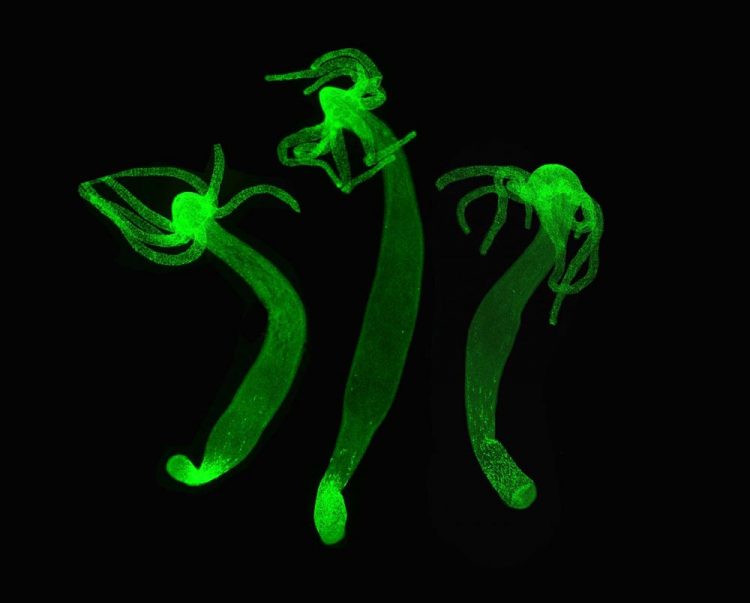Hydra can modify its genetic program

This image shows the nervous system of about 1 cm-long Hydra revealed here with a fluorescent green marker. Credit: © Brigitte Galliot
Champion of regeneration, the freshwater polyp Hydra is capable of reforming a complete individual from any fragment of its body. It is even able to remain alive when all its neurons have disappeared. Researcher the University of Geneva (UNIGE), Switzerland, have discovered how:
cells of the epithelial type modify their genetic program by overexpressing a series of genes, among which some are involved in diverse nervous functions. Studying Hydra cellular plasticity may thus influence research in the context of neurodegenerative diseases. The results are published in Philosophical Transactions of the Royal Society.
The freshwater Hydra is endowed with an extraordinary power of regeneration, discovered by the Swiss naturalist Abraham Trembley more than 250 years ago. The group of Brigitte Galliot, professor at the Department of Genetics and Evolution of the Faculty of Science of UNIGE, has studied the stem cells functioning and cellular plasticity of the polyp:
«its nervous system regulates in particular contraction bursts, feeding behavior, moving or swimming. If the stem cells responsible for its renewal are depleted, the Hydra can still develop, even when all its neurons have disappeared. We wanted to understand how this is possible.»
Enhancing other cells' sensing ability
The researchers compared gene expression at various positions along the body axis in polyps devoid or not of their nervous stem cells. They observed a modification of the genetic program in animals depleted of these cells: «we identified 25 overexpressed genes in epithelial cells, the cells forming the Hydra's coating tissues. Some of these genes are involved in diverse nervous functions, such as neurogenesis or neurotransmission», says Yvan Wenger, co-first author of the article.
«Epithelial cells do not possess typical neuronal functions. However, Hydra's loss of neurogenesis induces epithelial cells to modify their genetic program accordingly, indicating that they are ready to assume some of these functions.
These “naturally” genetically modified epithelial cells are thus likely to enhance their sensitivity and response to environmental signals, to partially compensate for the lack of nervous system», explains Wanda Buzgariu, co-first author of the article. The detail of these new functions remains to be discovered, as well as how epithelial cells proceed to overexpress these genes and thus adapt their genetic program.
Cellular plasticity maintains youth
Studying Hydra's cellular plasticity may be relevant in the context of neurodegenerative diseases. Indeed, some of the genes identified in this animal play an important role in cellular reprogramming or in neurogenesis in mammals. The researchers therefore wonder: would it be possible to restore sensing or secretion functions from other cell types, when some neurons degenerate?
This study also allows to go back to the origins of nervous systems. Epithelial cells most probably preceded nerve cells, performing some of their functions, although in a much slower way. «The loss of neurogenesis in Hydra may provide an opportunity to observe a reverse evolutive process, because it sheds light on a repressed ancestral genetic toolkit. An atavism of epithelial cells, when they most probably also possessed proto-neuronal functions», concludes Brigitte Galliot.
Media Contact
All latest news from the category: Life Sciences and Chemistry
Articles and reports from the Life Sciences and chemistry area deal with applied and basic research into modern biology, chemistry and human medicine.
Valuable information can be found on a range of life sciences fields including bacteriology, biochemistry, bionics, bioinformatics, biophysics, biotechnology, genetics, geobotany, human biology, marine biology, microbiology, molecular biology, cellular biology, zoology, bioinorganic chemistry, microchemistry and environmental chemistry.
Newest articles

A ‘language’ for ML models to predict nanopore properties
A large number of 2D materials like graphene can have nanopores – small holes formed by missing atoms through which foreign substances can pass. The properties of these nanopores dictate many…

Clinically validated, wearable ultrasound patch
… for continuous blood pressure monitoring. A team of researchers at the University of California San Diego has developed a new and improved wearable ultrasound patch for continuous and noninvasive…

A new puzzle piece for string theory research
Dr. Ksenia Fedosova from the Cluster of Excellence Mathematics Münster, along with an international research team, has proven a conjecture in string theory that physicists had proposed regarding certain equations….



